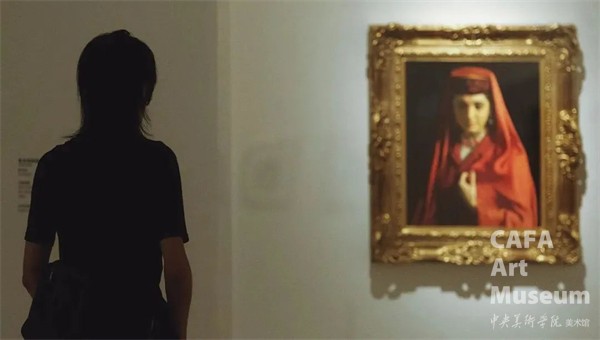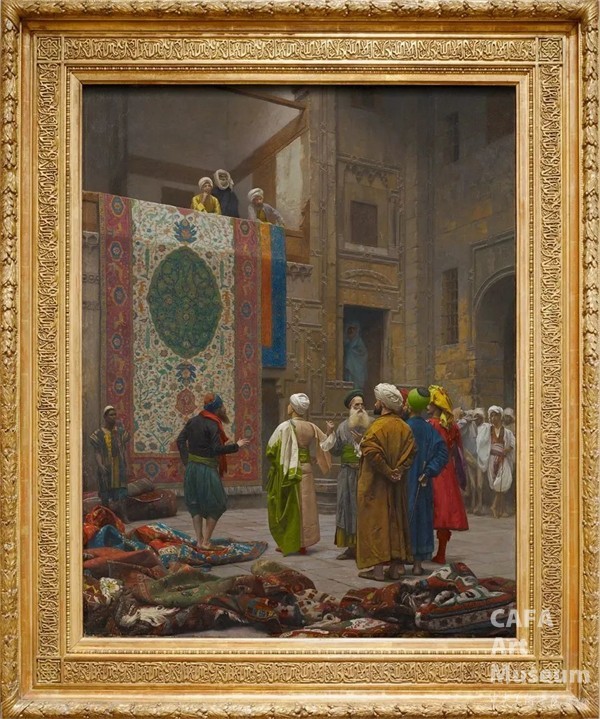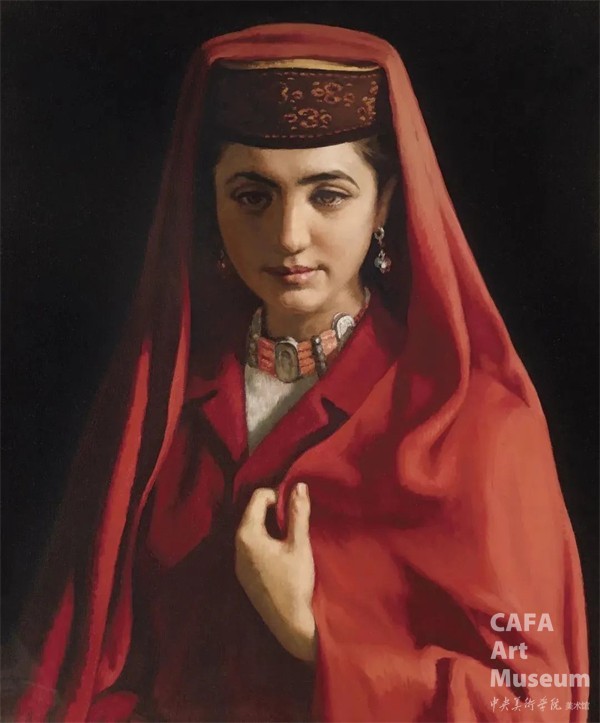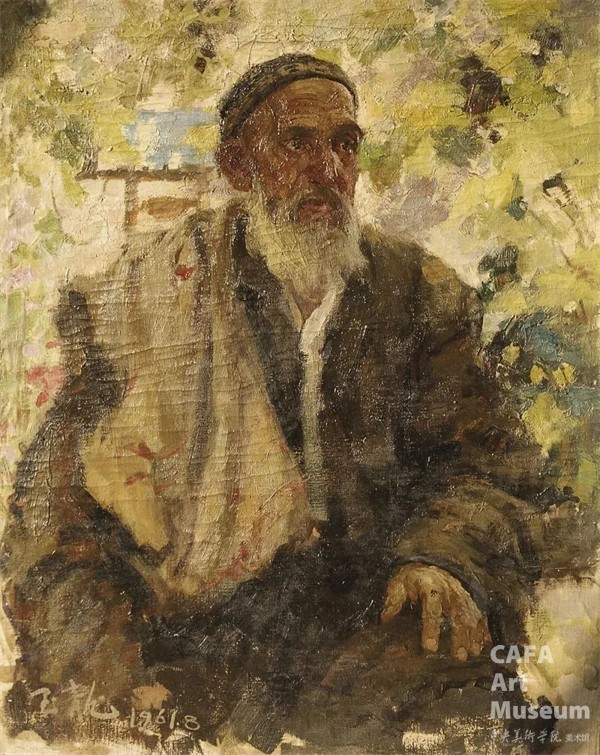

万方乐奏有于阗:“写生新疆:20世纪以来新疆主题创作研究展”评述
段牛斗
中央美术学院人文学院
暨非物质文化遗产研究中心讲师
《美术馆》2023年第4期
2023年7月12日至8月20日举行的“写生新疆:20世纪以来新疆主题创作研究展”是中央美术学院美术馆对于中国近现代美术与边疆民族主题的又一次回顾。民族图像与国家建构逐渐受到学术界重视,近年来,中央美术学院美术馆相继举办“淬砺求实,以真为师:潘世勋的速写与油画”(2019-2020)、“山河情:马常利油画艺术展”(2021)以及“心影馨香:孙宗慰绘画主题展”(2023)等展览,呈现了不同时代艺术家对于此类题材的表现,以及相关的文化、社会语境。
通过图像学和人类学视野,从看似普通、平常的题材当中梳理出复杂的历史信息和政治内涵,并回归美术本位研究,是笔者对一系列展览的最大观感。

展览现场
一、作为美术题材的新疆
在中国转向现代化民族国家的过程中,新疆成为政治格局当中的重要角色,而被文化艺术领域所重视。1 不过,对这一问题的考量经常会局限在一般意义上“少数民族题材美术”的范畴,往往对“少数民族”等概念不求甚解,也无法意识到创作群体的多元,容易被“题材”“美术”等常见概念所限制,所以,结论通常以描述为主,缺乏一定的思辨。
边塞,一直是中国艺术的重要题材,代表了对于古代中国文化和地理边界的想象。在封建社会末期,现代化的民族国家形态和国际政治关系逐渐确立,从乾隆皇帝的“十全武功”到晚清关于海防、塞防的争论,“边塞”的内涵和外延即将发生重要的变化 2 ——清代画家华嵒、任伯年的边塞绘画便创作于这一时期。光绪八年(1882),主张新疆建省的左宗棠谓之“他族逼处,故土新归”,“新疆”于是得名,此后,新疆与中原汉地不同的文化、自然特征越发受到关注,加之政治地位特殊,其形象逐渐变得立体和丰富。在这一过程当中,美术发挥了非常重要的作用,尤其是交通、科技不便的时代,成为内地社会了解边疆的重要载体。
新疆民族众多,而且风俗不同于中原,民国时期对各族的分布、语言和宗教已有深入认知。3 新疆题材美术作品的出现与救亡图存的政治背景相关,尤其是抗日战争时期。新疆艺术受到重视,一批留学苏俄的艺术家成为重要的创作力量,例如:著名的维吾尔族舞蹈家康巴尔汗,1942年回国之后曾在各地表演新疆传统舞蹈,尤其1947年在江苏、上海、浙江、台湾等地的巡演,政治意义重大。4 同时,出身英属西印度群岛的归侨舞蹈家戴爱莲也在研究包括新疆在内的中国民族民间舞蹈,在1946年的重庆举行“边疆音乐舞蹈大会”,直接影响了叶浅予的绘画创作,形成独具特色的水墨舞蹈人物题材。5 由此,边疆民族题材音乐、舞蹈与美术作品相互影响,这一潮流源于抗战,并延续至1949年以后,类似艺术传统的影响至今仍在,尤其以“十七年”时代最具典型性。正是由于这一背景,开创了对于西部传统艺术资源理论化、科学化的进程,使得以维吾尔族歌舞为主的新疆舞成为被人熟悉的艺术符号。所以,1949年之后最初的新疆美术作品有相当一部分与音乐、舞蹈相关,美术作品中维吾尔族人物最初也源于歌舞表演形象。
与新疆艺术走进内地相呼应的是当时流行的西部写生潮流,韩乐然、常书鸿、庞薰琹、吴作人、孙宗慰、关山月等画家深入各地,这一趋势对于中国近现代美术发展至关重要。6 于是,近代的国族建构成为新疆题材最为重要的背景,跨越不同时代,形成新疆相关美术创作的基本特征。

司徒乔 《套马》 97.5×222cm 布面油画 1955 中央美术学院美术馆藏
新疆是文明汇聚之地,拥有丰富、灿烂的文化遗产资源,能够被纳入艺术家视野的题材显然经过严格选择,需要紧扣民族、区域属性并符合意识形态要求。尤其在强调政治功能的时代,与宫廷、贵族、宗教相关的题材被降低到最低限度,而人物、服饰和风光等相对易于表达的内容显然更加常见。
作为美术题材的“新疆”包括但并不限于如下几种内涵:延续了对于边疆的想象;民族国家的政治符号;推动艺术变革的文化资源和历史机缘——因此,具备多元内涵的新疆题材在国家、知识和艺术现代化进程中逐渐确立了非常特殊的地位,而且随着时代发展而推陈出新。
二、从写生到创作
近年来,“主题性创作”被频繁提及,成为与国家、社会和公众密切相关的美术创作形式,主题创作的历史路径源于“革命历史画”“重大革命历史题材”等一系列由国家赞助的现实主义艺术工程。7 所以,在新疆题材开始流行之时,主题创作的概念尚未产生,本次展览内容虽以“主题”为名,而相当一部分作品却来自主题创作形成之前的时代。
与金戈铁马、气吞万里的边塞诗文不同,对于新疆风情的写生源于民族和国家观念形成关键期的民国时代,所以,艺术界对于边疆民族的再发现必然包含现实政治的因素。在当时,学术界、政治界也出现对于西部历史文化和社会经济的重视,所以,艺术界与此类似,画家通过写生和考察构建起对于民族、国家的最初认知。
一般而言,写生是为创作进行准备,只有产生真正的作品,写生的价值才能被最大化。不过,在本次展览当中,写生和创作之间呈现出非常复杂的关系,对于不同画家也有不同意义。8

〔法〕让·莱昂·杰罗姆(Jean-Leon Gerome) 《地毯商人》(The Carpet Merchant) 86.04×68.74cm 布面油画 约1887 美国明尼阿波利斯美术馆(Minneapolis Institute of Art)藏
显而易见,展览当中1949年以前作品的主题性较弱,多以写生为主,但也开始出现一些探索。其中,韩乐然的油画《毯市》(1945)是为数不多的追求“主题”意义的作品,临摹自法国十九世纪晚期绘画《地毯商人》 9 ——画家杰罗姆到过埃及,擅长描绘北非等地的风土人情,作品具有浓厚东方主义色彩。这幅作品临摹于韩乐然首次进疆的前一年,但他并未局限于欧洲画家视角,之后的多数作品面向丰富多彩的新疆百姓生活 10 ——在西北,除了描绘边疆风情、考察文物古迹,韩乐然试图将写生提升到创作的高度:若是对哈萨克族民俗略有了解,便能确定《天山脚下歌舞》(1946)源于写生,而非想象。11 不过,韩乐然的观念没有得到进一步实践,只留下了艺术路径的一些局部。12

韩乐然 《天山脚下歌舞》 48×63cm 布面油画 1946 家属藏
展览收录了叶浅予《新疆乐舞》(1986)、黄胄《毛驴》(1959),两位画家均以国画人物和边疆民族题材著称,很多作品介于写生和创作之间,不仅开创新的风格,而且也参与了民族和国家形象的表现。解放前,叶浅予的经历和创作已经受到徐悲鸿的重视,并与“新国画”相联系。13 叶浅予创作于1951至1953年主题为“民族大团结”(或“中华各民族大团结”)的系列作品,名称、构图和题材相似,是画家着力适应新社会的体现14 ——由于民族识别尚未完成,作品反映了当时的民族知识,而画家本人也有一定的民族学意识。15 黄胄曾经跟随赵望云、韩乐然前往西北写生,并且在解放后参军,又从西北军区、总政治部调任中国人民革命军事博物馆,军队文艺工作者必然强调政治功能。16 尤其是在社会环境要求中国画必须创新的背景下,以叶浅予、黄胄为代表的边疆人物画逐渐被社会和公众广泛接受,内容也不再限于新疆。17 今天,画家们依然喜欢描绘新疆的风土人情,但是未必知道题材背后的缘由,在经历复杂的双向选择之后,写生和创作之间的界限似乎不再明显——在画家选择题材的同时,也不自觉地被社会环境所选择。18

叶浅予 《新疆乐舞》 140×252cm 纸本设色 1986 中央美术学院美术馆藏
毫无疑问,靳尚谊创作于1983年的油画《塔吉克新娘》是展览最重要的作品,被视为中国新古典主义油画的代表,不过,无论是艺术家还是研究者,好像都忽视了这幅画背后丰富的人类学、社会学内涵:画家为什么采用新疆题材来表达如此宏大的艺术观念?答案并非巧合,而是在于延续了中国美术面向边疆、民族的传统,这一传统既是画家收集素材、获取灵感的需要,也是艺术现代化的重要资源 19 ——民国时期的画家如此,当代画家依然如此,是由艺术发展的内在规律和社会功能决定的。从某种意义上,甚至可以说第三部分“壮阔与崇高:新时期新疆题材的开拓(1979—2000)”是围绕《塔吉克新娘》的研究性扩展,极大延伸了学术视野。20 总之,从文化、社会视角来看,《塔吉克新娘》使得新疆题材突破了地域和族群限制,具备代表中国现当代油画的艺术高度,升华了创作和主题所代表的意义。与此类似,《归侨》(1980)、《青年女歌手》(1984)、《高原情》(1986)、《塔吉克青年》(1993)等均为代表靳尚谊中国新古典主义油画的系列作品,由此,以新疆写生为基础的创作被纳入表达中国文化的艺术意象之中。

靳尚谊 《塔吉克新娘》 60×50cm 布面油画 1983 机构收藏
在第一部分“激情与探险:现代新疆写生的先遣者(1949年以前)”,写生可以被视为某种形式的社会运动,有的画家兼具学者、革命家等多重身份,西部写生甚至衍生出社会启蒙、边疆建设的作用。到第二部分“开掘与新篇:新中国文艺政策下的西行之路(1949-1978)”,创作和主题的意识逐渐成熟,题材的目的和功能已经非常明确,这也是由社会主义文艺性质所决定。
三、民族、国家的图像表达
在跨越时代、政治的民族国家图像表达体系当中,不同的社群扮演了相应的政治角色 21 ——实际上,展览第二部分所涵盖的三十年可以分为两个阶段:“十七年”时期是民族、国家图像的形成和确定时期,而“文革”则固定了这一格局,之后基本没有发生变化——共产主义本身具有浓厚的国际主义色彩,对于意识形态的强调,必然导致国家、民族的历史文化特质被弱化。第二部分标题当中的“新中国文艺政策”也并非完全形成于新中国成立后,而是有一定源流并叠加了不同的历史印记,包括革命和国家、阶级和民族等互文式叙事。
1942年,毛泽东《在延安文艺座谈会上的讲话》奠定了解放区和新中国文艺的基调,如果说因此确立以工农兵为基础的阶级与革命视角,那么近代以来的西部写生则逐渐明确了民族与国家属性。
基于民族识别的少数民族形象,在民族、国家相关主题美术作品当中占据主角,而且新疆等主题往往突破了单一的地理或历史含义,覆盖了地域、族群、景观,例如:除了上文提及的叶浅予、黄胄,还包括韩乐然、赵望云和孙宗慰的西北题材,董希文、潘世勋和马常利的西藏题材,以及朱乃正的青海题材、孙景波的云南题材,也包括“北大荒版画”、首都国际机场壁画等展示民族边疆形象的艺术现象……画家、地域和民族已经形成密切而稳固的联系,这种联系不仅和画家个人经历相关,也是改革开放之前的社会环境所致。推而广之,展览对“新疆主题”的深入发掘可以视为关于“边疆民族主题”的个案研究,无论是民俗还是风光,其实都是对于民族、国家的图像再现。这一艺术范式的形成过程中,包括了不同时代艺术家的个人探索,更有对于同一主题的不断深入研究,显然,新疆属于其中的经典案例。

梁玉龙 《新疆背袋老人》 87×68cm 布面油画 1961 中央美术学院美术馆藏
美术史往往围绕画家、作品或流派而展开,但是,在不同时代,有不同的画家参与了民族图像与国家建构:对于罗工柳、钟涵、闻立鹏、全山石等知名画家,新疆代表了艺术生涯的某一片段,阿曼·穆罕诺夫、列阳、谭权书、李山、龙清廉、杨鸣山、谢家道等画家,或出身新疆本地,或毕业分配进疆,均有长期在新疆的生活经历——不同背景画家描绘新疆的目的必然存在差异。22 在新中国文艺制度下,这一系列工作体现了对于主题创作的赞助、组织和实施,呈现出完整的社会动员机制。秉持多元、动态又开放的态度,为传统的美术史研究增加了新内容,也提供了探讨美术作品文化、社会意义的新路径。

阿曼·穆罕诺夫 《葡萄架下》 120×170cm 布面油彩 1963 中央美术学院美术馆藏
虽然策展人是按照历史阶段对展品进行组织,但是如果根据不同的标准,还是能够从中梳理出另外一些线索——艺术家群体对新疆文化遗产的发现、保护和研究;边疆写生对中国画创新的意义;国家对新疆美术力量的组织和训练;著名艺术家的新疆情结;当代艺术、信息时代与民族国家叙事……在第四部分“历史与现实:新世纪的视野(2000年以来)”已经有所反映。
第五部分“当代艺术实践的个案研究”相对独立,体现了刘小东、刘商英等艺术家近年来的实践,在某种程度上,是一种去地域化、去族群化的新疆题材。社群则被放置于另一种维度之中:意义不再单一,而是充满复杂和矛盾,可以理解为某种消解或涵化,显而易见,民族边疆题材其实是中国近现代和当代美术变迁的缩影。23

刘小东 《土孩儿》 150×140cm 布面油画 2013 中央美术学院美术馆藏
结 语
1950年10月,国庆一周年之际,各少数民族代表在中南海怀仁堂欢聚,毛泽东写下著名的《浣溪沙·和柳亚子先生》,所谓“万方乐奏有于阗,诗人兴会更无前”——从诗意到画意,“新疆主题”逐渐得到升华。
从清末到21世纪初,新疆题材经过了时代、政治的多重选择,既令人熟悉但似乎又有距离感。首先,新疆题材是民族国家艺术范式的重要内容,包括清代边塞主题的复兴,民国以来的西部写生,以及新中国文艺的组织、动员,已经成为内容丰富的文化现象,展览扩展了“新疆主题”的来源和意义,超越了“少数民族题材”等简单化认知。其次,在新中国文艺政策的影响下,“新疆主题”通常需要兼顾意识形态和历史文化,但是随着不同时代的政策调整,经常会有所偏重,如何以地域、民族展示政治,是“新疆主题”的根本,也在很大程度上影响人们对新疆及相关艺术创作的认知。第三,一些新疆题材作品突破内容和功能的局限而成为艺术经典,展览充分阐释写生和创作的关系,分析部分名家、名作的渊源和影响,上升到边疆民族与中国美术关系的高度——这种跨媒介的艺术现象在同题材音乐、舞蹈和影视作品当中也有出现——如此种种,绝非所谓“自我东方主义”(inner orientalism)所能涵盖。24
总之,无论是“民族图像与国家建构”,或者是“中华民族视觉形象”,在不同视角下,更多信息和细节仍然有待于进一步研究。
注释
1 相关研究参见刘曦林《先行者的足迹:1930至1970年代新疆题材绘画概述》,《美术》2011年12期;康书增《1949年以来的新疆中国画》,选自中国美术家协会等编《天山南北:中国美术作品集》,人民美术出版社,2011年。
2 相关研究参见牟安世《论中国近代史上的“塞防”与“海防”之争》,《河北学刊》1986年第5期;赖毓芝《构筑理想帝国:〈职贡图〉与〈万国来朝图〉的制作》,《紫禁城》2014年第10期。
3 吴启讷《人群分类与国族整合:中共民族识别政策的历史线索和政治面向》,选自余敏玲主编《两岸分治:学术建制、图像宣传与族群政治(1945-2000)》,中央研究院近代史研究所,2012年,第342-344页。
4 李双《文化交流与情感沟通:1947-1948 年新疆青年歌舞团参访演出启示》,《北方民族大学学报(哲学社会科学版)》2022年第4期。
5 刘青弋《1946:“边疆音乐舞蹈大会”——七十年后值得钩沉的历史》,《北京舞蹈学院学报》2017年第1期。
6 相关研究参见曾蓝莹《边疆与内地的互置:吴作人画中的西北意向》,选自区域与网络国际学术研讨会论文集编辑委员会编《区域与网络:近千年来中国美术史研究国际学术研讨会论文集》,台湾大学艺术史研究所,2001年;吴洪亮《漫道寻真:庞薰琹、吴作人、孙宗慰、关山月二十世纪三十至四十年代西南、西北写生及其创作》,《美术学报》2013年第6期;孙丹妮《敦煌经验与民族志之眼:孙宗慰的西北写生(1941-1942)》,《美术学报》2022年第6期。
7 曾小凤《从“革命历史画”到“主题性美术”:以美术工程为视角的历史叙事》,《艺术工作》2023年第2期。
8 哈孜·艾买提口述,刘建新、买买提·艾依提整理《新疆油画历史回顾》,选自中国美术家协会等编《天山南北:中国美术作品集》,人民美术出版社,2011年。
9 《地毯商人》(The Carpet Merchant),布面油画,86.04×68.74cm,法国画家让·莱昂·杰罗姆(Jean-Leon Gerome,1824-1904)创作于约1887年,美国明尼阿波利斯美术馆(Minneapolis Institute of Art)藏。
10 安雪《现实·诗意·民族性:评韩乐然新疆时期的绘画特色》,《美术》2011年第12期。
11 陈旭《边疆、民族与国族建构:20世纪40年代的旅边写生与哈萨克族人的形塑》,《美术》2023年第1期。
12 黄胄《西塞椽笔 大漠飞虹:忆念老师韩乐然》,《社会科学战线》1982年第4期。
13 徐悲鸿《叶浅予之国画》,原载《益世报·艺术周刊》(1948年2月13日),收入王震、徐伯阳编《徐悲鸿艺术文集》,宁夏人民出版社,1994年。
14 系列作品当中以《民族大团结》(141×246cm,纸本工笔重彩,1953,中国美术馆藏)最为著名,其余作品至少有三幅,名称、内容、尺幅、材质、时间均有不同,分别收藏在中国美术馆、中央美术学院美术馆等处。周方涵《“自觉”图解:叶浅予〈民族大团结〉图像分析》,中央美术学院学士学位论文,2017年,第5、18页;张树轩《20世纪50年代初叶浅予“民族团结”主题绘画研究》,《美术观察》2023年第5期。
15 芮毅《传统与现代的互融:叶浅予与珂弗罗皮斯的民族学研究》,《美术》2013年第5期。
16 李松《艺术长青 大业馨香:黄胃的艺术和他的艺术事业》,《美术》1997年第8期。
17 宋晓霞《黄胄与20世纪少数民族题材美术创作》,《美术》2019年第2期。
18 吴雪杉《“新国画”:徐悲鸿与“新兴作家”的出场》,《中国美术》2016年第6期;杨灿伟《多重身份交织下的枢纽人物:20世纪50年代前后的叶浅予》,《美术》2017年第10期。
19 赵凤兰《用西方油画语言为中国人造像:访画家靳尚谊》,《中国文艺评论》2019年第11期。
20 尚辉《壮阔与崇高:新时期新疆题材美术创作的审美价值与艺术成就》,《美术》2011年12期。
21 段牛斗《万民来朝:民族团结形象演变》,《新知》2014年第5期。
22 康书增《建国后支边新疆美术家研究》,《美术观察》2010年第11期。
23 宋晓霞《藏族题材与当代中国艺术》,《美术》2010年第1期。
24 〔英〕柯律格(Craig Clunas)著、刘颖译《中国艺术》,上海人民出版社,2013年,第219页。

国家艺术基金资助项目
中国福利彩票和中国体育彩票彩票公益金资助
写生新疆:20世纪以来新疆主题创作研究展
展览时间:2023.7.12-8.20
展览地点:中央美术学院美术馆2层B展厅
资助单位:国家艺术基金
主办单位:中央美术学院
承办单位:中央美术学院美术馆
支持单位:中国美术馆 新疆美术馆 黑龙江省美术馆 浙江华茂艺术教育博物馆 懋源泓斋
鸣谢:罗安 闻丹青 韩健立 蒋雯丽
学术主持:邱志杰
总策划: 张子康
学术顾问:曹庆晖
展览总监:韩文超
展览统筹:王春辰 高高
策展人: 郭小晖 王静
设计协调:纪玉洁
视觉设计:孙彤
展览艺术家
(按出生时间排列)
韩乐然、司徒乔、叶浅予、王合内、罗工柳、戴泽、梁玉龙、黄胄、伍必端、李山、列阳、钟涵、全山石、闻立鹏、杨鸣山、靳尚谊、庞均、谭权书、阿曼·穆罕诺夫、谢家道、苏高礼、龙清廉、龚建新、文国璋、范迪安、李晓林、张群、于小冬、刘小东、杨茂源、胡西丹·克里木、赵培智、刘商英、刘雨佳、康春慧
